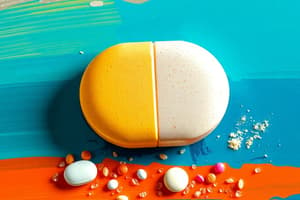Podcast
Questions and Answers
What is the primary method of delivering insulin since the 1920s?
What is the primary method of delivering insulin since the 1920s?
- Nasal spray
- Intravenous injection (correct)
- Oral delivery
- Transdermal patch
Which method is commonly used to avoid first-pass metabolism?
Which method is commonly used to avoid first-pass metabolism?
- Intramuscular injection
- Intravenous injection (correct)
- Oral delivery
- Nasal administration
What challenge still exists with oral delivery of protein drugs?
What challenge still exists with oral delivery of protein drugs?
- Inability to use patches
- Deactivation by stomach acids (correct)
- Pain during administration
- Absorption through the bloodstream
Why is the intestinal barrier considered a significant challenge in protein drug delivery?
Why is the intestinal barrier considered a significant challenge in protein drug delivery?
What type of injection is typically used for most vaccines?
What type of injection is typically used for most vaccines?
Which delivery method can lead to tissue necrosis if repeated often?
Which delivery method can lead to tissue necrosis if repeated often?
What is a significant barrier proteins face when delivered orally?
What is a significant barrier proteins face when delivered orally?
What strategy is being researched to improve oral delivery of protein drugs?
What strategy is being researched to improve oral delivery of protein drugs?
Which of the following routes is NOT part of parental delivery methods?
Which of the following routes is NOT part of parental delivery methods?
What is a potential downside of using injectable methods for protein drugs?
What is a potential downside of using injectable methods for protein drugs?
Flashcards
Protein Drug Delivery Methods
Protein Drug Delivery Methods
Different ways to get protein drugs into the bloodstream, such as injection (subcutaneous, intravenous, intramuscular, intradermal), oral, nasal, and patch delivery.
Intravenous Injection
Intravenous Injection
Injecting drugs directly into a vein or artery, delivering them quickly and directly into the bloodstream.
Intramuscular Injection
Intramuscular Injection
Injecting drugs into a muscle, providing sustained release and absorption into the bloodstream.
Subcutaneous Injection
Subcutaneous Injection
Signup and view all the flashcards
Oral Delivery of Proteins
Oral Delivery of Proteins
Signup and view all the flashcards
First-Pass Metabolism
First-Pass Metabolism
Signup and view all the flashcards
Intestinal Barrier
Intestinal Barrier
Signup and view all the flashcards
Mucus Barrier
Mucus Barrier
Signup and view all the flashcards
Tissue Necrosis
Tissue Necrosis
Signup and view all the flashcards
Protein Formulation Techniques
Protein Formulation Techniques
Signup and view all the flashcards
Study Notes
Drug Delivery Methods
- Various routes exist for delivering drugs into the bloodstream, including subcutaneous, intravenous, oral, patch, etc.
- The common method for insulin and many peptide/protein drugs is injection (parenteral).
- Oral, nasal delivery are used often for smaller molecules.
- Patch delivery exists for some drugs like nicotine.
- Some locations (nose, lungs, rectum, vagina, eyes) have thinner tissue layers, aiding protein penetration.
Parenteral Delivery (Injection)
- Includes intravenous (IV), intramuscular (IM), subcutaneous (SQ), and intradermal.
- IV: Injection into veins/arteries. This is a common method for protein drugs, offering complete absorption, reduced waste, and avoidance of first-pass metabolism.
- IM: Used for many vaccines.
- SQ: A less invasive method than IV.
- Risks associated with repeated injection include tissue damage (necrosis), overdose, local reactions, and hypersensitivity reactions.
- Injection is often painful, decreasing patient acceptance.
Oral Delivery
- Active research area, but widespread oral delivery of proteins is less likely.
- Proteins are deactivated by enzymes in the digestive system.
- Formulations are being developed to protect proteins from degradation.
- The intestinal barrier prevents most proteins from being absorbed.
- The mucus layer, while protective, is a significant barrier.
Intestinal Barrier
- The intestines absorb nutrients.
- The small intestine is the primary absorption site.
- Absorption methods include transcellular (through cells), paracellular (between cells), and via specific protein transporters.
- The mucus layer presents a challenge to absorption.
Studying That Suits You
Use AI to generate personalized quizzes and flashcards to suit your learning preferences.
Description
Explore various drug delivery routes, including parenteral methods like intravenous and subcutaneous injections. Understand the advantages and risks associated with each method, as well as their applications in treating different conditions. This quiz covers essential concepts related to pharmacology and drug administration.




